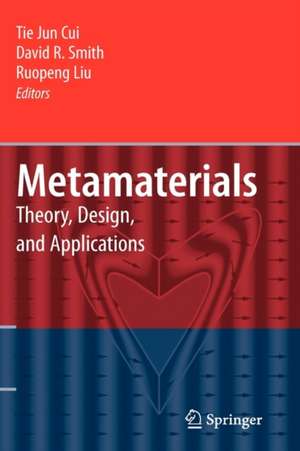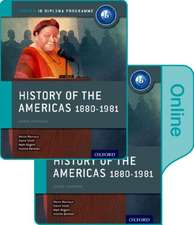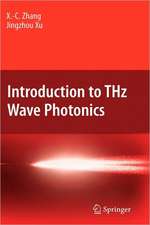Metamaterials: Theory, Design, and Applications
Editat de Tie Jun Cui, David Smith, Ruopeng Liuen Limba Engleză Hardback – 16 noi 2009
| Toate formatele și edițiile | Preț | Express |
|---|---|---|
| Paperback (1) | 792.30 lei 38-44 zile | |
| Springer Us – 30 noi 2014 | 792.30 lei 38-44 zile | |
| Hardback (1) | 955.08 lei 6-8 săpt. | |
| Springer Us – 16 noi 2009 | 955.08 lei 6-8 săpt. |
Preț: 955.08 lei
Preț vechi: 1164.73 lei
-18% Nou
Puncte Express: 1433
Preț estimativ în valută:
182.76€ • 191.69$ • 152.14£
182.76€ • 191.69$ • 152.14£
Carte tipărită la comandă
Livrare economică 01-15 aprilie
Preluare comenzi: 021 569.72.76
Specificații
ISBN-13: 9781441905727
ISBN-10: 1441905723
Pagini: 392
Ilustrații: XXIII, 367 p.
Dimensiuni: 155 x 235 x 33 mm
Greutate: 0.72 kg
Ediția:2010
Editura: Springer Us
Colecția Springer
Locul publicării:New York, NY, United States
ISBN-10: 1441905723
Pagini: 392
Ilustrații: XXIII, 367 p.
Dimensiuni: 155 x 235 x 33 mm
Greutate: 0.72 kg
Ediția:2010
Editura: Springer Us
Colecția Springer
Locul publicării:New York, NY, United States
Public țintă
Professional/practitionerCuprins
to Metamaterials.- Optical Transformation Theory.- General Theory on Artificial Metamaterials.- Rapid Design for Metamaterials.- Broadband and Low-Loss Non-Resonant Metamaterials.- Experiment on Cloaking Devices.- Finite-Difference Time-Domain Modeling of Electromagnetic Cloaks.- Compensated Anisotropic Metamaterials: Manipulating Sub-wavelength Images.- The Dynamical Study of the Metamaterial Systems.- Photonic Metamaterials Based on Fractal Geometry.- Magnetic Plasmon Modes Introduced by the Coupling Effect in Metamaterials.- Enhancing Light Coupling With Plasmonic Optical Antennas.- Wideband and Low-Loss Metamaterials for Microwave and RF Applications: Fast Algorithm and Antenna Design.- Experiments and Applications of Metamaterials in Microwave Regime.- Left-Handed Transmission Line of Low Pass and Its Applications.
Textul de pe ultima copertă
Metamaterials: Theory, Design and Applications focuses on the most recent research activity in metamaterials, taking a reader beyond previously covered areas like left-handed materials (LHM) and negative index materials (LIM). Some new developments covered in the book include a rapid design method for inhomogeneous metamaterials, microwave and RF applications of metamaterials and dynamic metamaterial systems. Editors Tie Jun Cui, David R. Smith and Ruopeng Liu bring together the leading international minds focused on metamaterials to provide an all-encompassing look at a rapidly-developing field. This book stands alone as a must-read for any engineer or researcher working with metamaterials.
Drawing on their years of experience in the field, editors Tie Jun Cui, David R. Smith and Ruopeng Liu present a breadth of research in metamaterials, covering areas like:
Drawing on their years of experience in the field, editors Tie Jun Cui, David R. Smith and Ruopeng Liu present a breadth of research in metamaterials, covering areas like:
- Optical transformation theory, including invisible cloaks, concentrators, beam splitters and antennas.
- Photonic metamaterials and the magnetic Plasmon effect.
- Experimental verification techniques for invisible cloaks.
Caracteristici
Coverage of optical transformation theory, including the invisible cloaks, concentrators, beam splitters and antennas New rapid design of inhomogeneous metamaterials Experimental verification techniques for invisible cloaks Discusses microwave and RF applications of metamaterials New material on the photonic metamaterials and the magnetic plasmon effects




















